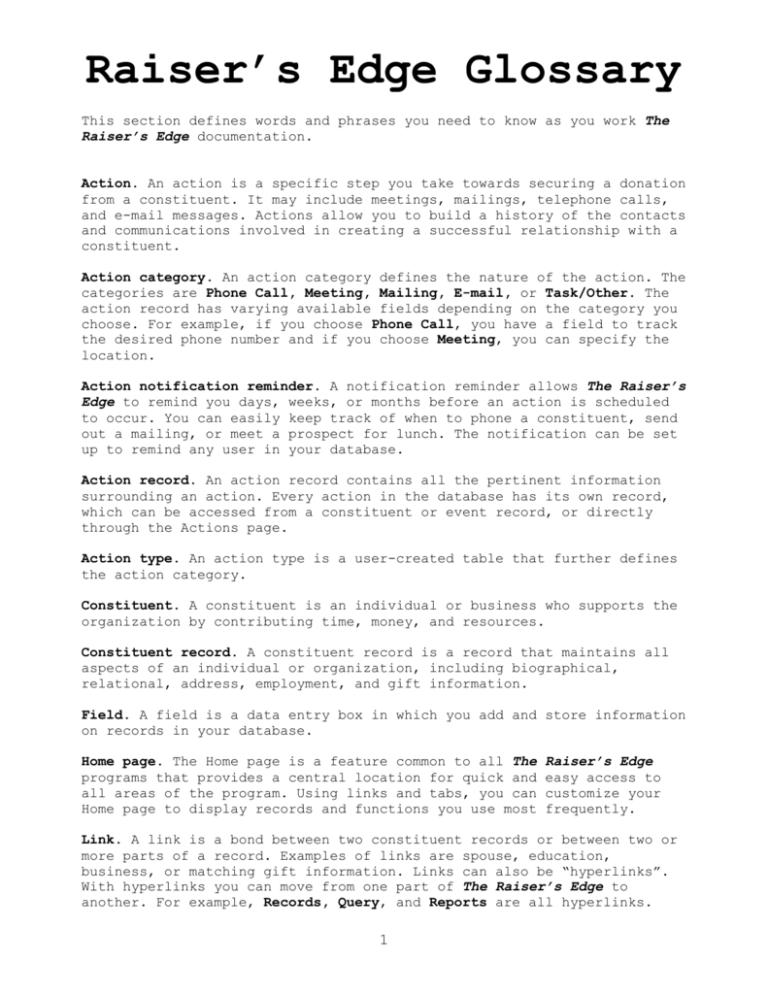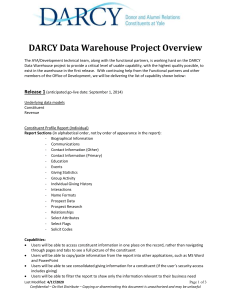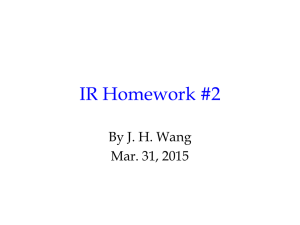Glossary of Raiser`s Edge Terms
advertisement

Raiser’s Edge Glossary This section defines words and phrases you need to know as you work The Raiser’s Edge documentation. Action. An action is a specific step you take towards securing a donation from a constituent. It may include meetings, mailings, telephone calls, and e-mail messages. Actions allow you to build a history of the contacts and communications involved in creating a successful relationship with a constituent. Action category. An action category defines the nature of the action. The categories are Phone Call, Meeting, Mailing, E-mail, or Task/Other. The action record has varying available fields depending on the category you choose. For example, if you choose Phone Call, you have a field to track the desired phone number and if you choose Meeting, you can specify the location. Action notification reminder. A notification reminder allows The Raiser’s Edge to remind you days, weeks, or months before an action is scheduled to occur. You can easily keep track of when to phone a constituent, send out a mailing, or meet a prospect for lunch. The notification can be set up to remind any user in your database. Action record. An action record contains all the pertinent information surrounding an action. Every action in the database has its own record, which can be accessed from a constituent or event record, or directly through the Actions page. Action type. An action type is a user-created table that further defines the action category. Constituent. A constituent is an individual or business who supports the organization by contributing time, money, and resources. Constituent record. A constituent record is a record that maintains all aspects of an individual or organization, including biographical, relational, address, employment, and gift information. Field. A field is a data entry box in which you add and store information on records in your database. Home page. The Home page is a feature common to all The programs that provides a central location for quick and all areas of the program. Using links and tabs, you can Home page to display records and functions you use most Raiser’s Edge easy access to customize your frequently. Link. A link is a bond between two constituent records or between two or more parts of a record. Examples of links are spouse, education, business, or matching gift information. Links can also be “hyperlinks”. With hyperlinks you can move from one part of The Raiser’s Edge to another. For example, Records, Query, and Reports are all hyperlinks. 1 Raiser’s Edge Glossary Media object. A media object is an electronic copy of something such as a newspaper clipping, letter, picture, or graph that pertains to a constituent and is stored on the Media tab of his constituent record. The Media tab uses Object Linking and Embedding (OLE) to store these newspaper clippings, letters, pictures, graphs, and other important data about your constituents. Proposal. A proposal is a gift request made by the organization. For example, if you discover a constituent has inherited $1,000,000 and your organization decides to pursue the constituent for a donation, you can enter a proposal in the program, documenting a purpose for the donation; how much you requested and when; the campaign, fund, or appeal involved; and the proposal’s status. You enter proposals on the Prospect tab in the constituent’s record. Prospect. The prospect is the source from whom the organization is cultivating a gift. For example, if you discover Dr. Robert C. Hernadez, M.D. has inherited $1,000,000 and your organization decides to pursue him for a donation, Dr. Hernadez is a prospect. Query. Query is the means by which you flag, group, and list selected records from your database. You can create dynamic and static queries specific to key areas of The Raiser’s Edge based on a set of criteria you define. Although queries group entire records, you can limit and sort the output information included in query results. You can use saved queries to limit the information processed in Records, Mail, and other areas of The Raiser’s Edge. Using queries in this manner reduces data processing time. Query format. Queries can be created in one of two formats: Dynamic and Static. Static queries search the database and generate a list of records that match the specified criteria at a specific point in time. Dynamic queries search the database and return records that match the criteria using the current database of information. Query type. Query types correspond to specific application records. These vary according to the program you are using. Your selection identifies the record type you want to query and makes a list of that record’s fields available for filtering, output, and sorting. Rating. A rating is a detailed analysis of gift and constituent prospects, usually performed by an outside research company. Ratings information is based on a study of wealth of individuals and organizations. The results usually include a category, such as target gift or asset level, along with an amount description suggesting what your organization can realistically expect to receive from the individual or organization. Record. A record is a page in The Raiser’s Edge from which you add, edit, and delete information such as names, addresses, relationships, gifts, memberships, events. Records is also an area in The Raiser’s Edge where you can manage records. 2 Raiser’s Edge Glossary Relationship. A relationship is defined as a familial or social association with a constituent. In The Raiser’s Edge, you can track five different types of relationships for a constituent. These relationships are individual (friends, family members, associates), organization (businesses, clubs, employers), bank (financial institutions), education (schools, colleges, and universities), and assigned canvasser (individuals or organizations assigned to secure donations from the constituent). Short-cut menu. A shortcut menu is a list of commonly used commands you can select to quickly perform actions or to display properties. Open, Delete, Print, and Properties are common shortcut menu items. To access shortcut menus, place your cursor in a field or grid and click the right mouse button. Static query. A static query is a query that provides a record of query output that existed at the time you established the query. If you run a report two months later using the same query, the system restricts the new output to only the records from the original query. Data entered after the original query is disregarded. Status bar. The status bar is a horizontal strip at the bottom of a screen that displays important messages to assist you in the program. For example, when the cursor is in a field with a table lookup available, “Press F7 for Table Lookup” appears in the status bar. Tab. A tab is a design element that appears at the top of some screens in The Raiser’s Edge. Tabs work to separate options into themed groups. For instance, you will find formatting options on various system Format tabs. Table. A table is a field in which you can pre-define entries to save time and promote consistency for your data entry. Title bar. A title bar is a horizontal strip at the top of a screen that identifies a program or file. Toolbar. A toolbar is a horizontal strip with buttons that, when clicked, perform specific tasks. It is located under the title bar at the top of a screen. Common toolbar buttons include New, Open, Save, and Print. For support: Contact GSU Helpdesk @ Help@langate.gsu.edu 3





